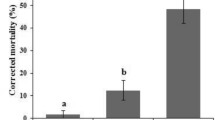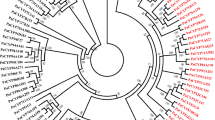Abstract
Temperature is an important factor influencing the physiological activities of agricultural pests. Therefore, understanding pest physiological activities and the molecular response to high-temperature stress is of paramount importance for pest management. Tetranychus truncatus Ehara (Acari: Tetranychidae) is a harmful organism, that may cause serious harm to crops such as corn and cotton in high-temperature environments. Cytochrome P450 (CYP450) is induced by high-temperature stress, and it plays an important role in the resistance of spider mites to high temperatures. Because of their role in high-temperature tolerance, the cytochrome P450 genes of the spider mite are attracting more and more attention. In this study, we identified and analyzed CYP450 genes in T. truncatus to investigate their potential roles in growth and development and the resistance to high-temperature stress. Based on phylogenetic and structural analyses, we identified 17 CYP450 genes in T. truncatus. RNA-seq and real-time quantitative PCR (RT-qPCR) revealed differential expression patterns of these genes at different developmental stages and levels of high-temperature stress resistance. The RNA interference results of selected CYP450 showed that when TtCYP3A2 and TtCYP4V2 were silenced by feeding on dsRNA, respectively, the high-temperature resistance of T. truncatus was decreased, which indicated that the expression of these two CYP450 genes in this species may be related to high-temperature tolerance. Our results provide potential evidence for the response of spider mites to high-temperature stress and help to improve the understanding of T. truncatus’s ability to resist high-temperature stress.







Similar content being viewed by others
Data availability
The raw data supporting the conclusions of this article will be made available by the authors, without undue reservation.
References
Ashraf HJ (2021) Comparative transcriptome analysis of Tamarixia radiata (Hymenoptera: Eulophidae) reveals differentially expressed genes upon heat shock. Comp Biochem Phys D 41:100940–100940. https://doi.org/10.1016/J.CBD.2021.100940
Chen H, Xu XL, Li YP, Wu JX (2014) Characterization of heat shock protein 90, 70 and their transcriptional expression patterns on high temperature in adult of Grapholita molesta (Busck). Insect Sci 21(4):439–448. https://doi.org/10.1111/1744-7917.12057
Daimon T, Shinoda T (2013) Function, diversity, and application of insect juvenile hormone epoxidases (CYP 15). Biotechnol Appl Biochem 60(1):82–91. https://doi.org/10.1002/bab.1058
DeLucia EH, Nabity PD, Zavala JA, Berenbaum MR (2012) Climate change: resetting plant-insect interactions. Plant Physiol 160(4):1677–1685. https://doi.org/10.1104/pp.112.204750
Dong Z, Hou R, Ouyang Z, Zhang R (2013) Tritrophic interaction influenced by warming and tillage: a field study on winter wheat, aphids and parasitoids. Agric Ecosyst Environ 181:144–148. https://doi.org/10.1016/j.agee.2013.09.009
Elzaki M, MiAh M (2018) Deltamethrin is metabolized by CYP 6FU1, a cytochrome P450 associated with pyrethroid resistance, in Laodelphax striatellus. Pest Manag Sci 74(6):1265–1271. https://doi.org/10.1002/ps.4808
Fu WH, Qiao WQ, Zhang CW, Zhang SH, Wang JZ (2021) Stress response of T. truncatus under pyridaben and high temperature stress. Chin J Appl Entomol 58(05):1152–1158
Gao X, Zhu X, Wang C, Wang L, Zhang K (2022) Silencing of cytochrome p450 gene AgoCYP6CY19 reduces the tolerance to host plant in Cotton- and Cucumber-Specialized Aphids, Aphis gossypii. J Agric Food Chem 70(39):12408–12417. https://doi.org/10.1021/acs.jafc.2c05403
Guo YL (2013) Growth and reproduction of Tetranychus turkestani and Tetranychus truncatus (Acari: Tetranychidae) on cotton and corn. Syst Appl Acarol-UK 18(1):89–98
Hasanvand I, Jafari S, Khanjani M (2020) Effect of temperature on development and reproduction of Tetranychus kanzawai (Tetranychidae) fed on apple leaves. Int J Acarol 46(1):31–40. https://doi.org/10.1080/01647954.2019.1694582
Huang HJ (2017) Comparative analysis of the transcriptional responses to low and high temperatures in three rice planthopper species. Mol Ecol 26(10):2726–2737. https://doi.org/10.1111/mec.14067
Jin PY (2018) Spider mites of agricultural importance in China, with focus on species composition during the last decade (2008–2017). Syst Appl Acarol-UK 23(11):2087–2098
Kim FR (2006) Marine invertebrate cytochrome P450: Emerging insights from vertebrate and insect analogies. Comp Biochem Phys C 143(4):363–381. https://doi.org/10.1016/j.cbpc
Li BL (2019a) Transcriptomic analysis of differentially expressed genes in the oriental armyworm Mythimna separata Walker at different temperatures. Comp Biochem Phys D 30:186–195. https://doi.org/10.1016/j.cbd.2019.01.011
Li JX (2019b) The CncC/keap1 pathway is activated in high temperature-induced metamorphosis and mediates the expression of Cyp450 genes in silkworm, Bombyx mori. Biochem Bioph Res Commun 514(4):1045–1050. https://doi.org/10.1016/j.bbrc.2019.05.052
Li J, Wang XP, Wang MQ, Ma WH, Hua HX (2013) Advances in the use of the RNA interference technique in Hemiptera. Insect Sci 20(1):31–39. https://doi.org/10.1111/j.1744-7917.2012.01550
Li J, Mao T, Wang H, Lu Z, Qu J (2019) The CncC/keap1 pathway is activated in high temperature-induced metamorphosis and mediates the expression of Cyp450 genes in silkworm, Bombyx mori. Biochem Biophys Res Commun 514(4):1045–1050. https://doi.org/10.1016/j.bbrc.2019.05.052
Luong HNB, Kalogeridi M, Vontas J, Denecke S (2022) Using tissue specific P450 expression in Drosophila melanogaster larvae to understand the spatial distribution of pesticide metabolism in feeding assays. Insect Mol Biol 31(3):369–376. https://doi.org/10.1111/IMB.12765
Md. Tarikul I (2017) Host-dependent life history and life table parameters of Tetranychus truncatus (Acari: Tetranychidae). Syst Appl Acarol-UK 22(12):2068–2082
Meynard CN, Migeon A, Navajas M (2017) Uncertainties in predicting species distributions under climate change: a case study using Tetranychus evansi (Acari: Tetranychidae), a widespread agricultural pest. PLoS ONE 8(6):e66445. https://doi.org/10.1371/journal.pone.0066445
Ming Y (2022) The role of insect cytochrome P450s in mediating insecticide resistance. Agriculture 12(1):53–53. https://doi.org/10.3390/AGRICULTURE12010053
Nikou D, Ranson H, Hemingway J (2003) An adult-specific CYP6 P450 gene is overexpressed in a pyrethroid-resistant strain of the malaria vector, Anopheles gambiae. Gene 318:91–102. https://doi.org/10.1016/s0378-1119(03)00763-7
Pahlavan Yali M, Razmjou J, Khanjani M, Golizadeh A, Hassanpour M (2012) Life history traits of Tetranycopsis horridus (Canestrini and Fanzago) (Acari: Tetranychidae) at three constant temperatures. Int J Acarol 38(3):251–256. https://doi.org/10.1080/01647954.2011.633560
Perrin M, Moiroux J, Maugin S, Olivares J, Rault M, Siegwart M (2022) Cross effects of heat stress and three insecticides on the survival of the codling moth Cydia pomonella (L.): Investigating the molecular and biochemical mechanisms. Pestic Biochem Phys 185:105139. https://doi.org/10.1016/J.PESTBP.2022.105139
Safeena MAA, Srinivasa N, Agarwal A (2021) Temperature dependent development, reproduction and population performance of Tetranychus hirsutus Zeity & Srinivasa (Acari: Tetranychidae), on medicinal herb, Gymnema sylvestre. Pest Manag Hortic Ecosyst 27(2):225–231
Sentis A, Morisson J, Boukal DS (2015) Thermal acclimation modulates the impacts of temperature and enrichment on trophic interaction strengths and population dynamics. Glob Chang Biol 21:3290–3298. https://doi.org/10.1111/gcb.12931
Shen XN (2021) The role of cytochrome P450 4C1 and carbonic anhydrase 3 in response to temperature stress in Bemisia tabaci. InSects 12(12):1071–1071
Skirvin DJ (2000) Mites: ecology, evolution and behaviour. Bull Entomol Res 90(1):97–98. https://doi.org/10.1017/S0007485300000146
Smith FF, Scott JG (1997) Functional expression of house fly (Musca domestica) cytochrome P450 CYP6D1 in yeast (Saccharomyces cerevisiae). Insect Biochem Mol Biol 27(12):999–1006. https://doi.org/10.1016/s0965-1748(97)00055-6
Song LW, Shen HM (2014) Effect of temperature on development and fecundity of pyridaben resistant and susceptible populations of Tetranychus truncatus Ehara (Acari: Tetranychidae). Chin J Eco-Agric 22(06):668–674
Sun W (2010) Expression characteristics of esterase gene in T. cinnabarinus under chemical stress. Southwest University
Tan SY (2022) Functional characterization of four Hsp70 genes involved in high-temperature tolerance in Aphis aurantii (Hemiptera: Aphididae). Int J Biol Macromol 202:141–149. https://doi.org/10.1016/J.IJBIOMAC.2022.01.078
Teng HY, Zuo YY, Yuan J (2022) High frequency of ryanodine receptor and cytochrome P450 CYP9A186 mutations in insecticide-resistant field populations of Spodoptera exigua from China. Pestic Biochem Phy 186:105153. https://doi.org/10.1016/j.pestbp.2022.105153
Vatanparast M, Park Y (2022) Differential transcriptome analysis reveals genes related to low- and high-temperature stress in the fall armyworm, Spodoptera frugiperda. Front Physiol 12:827077–827077. https://doi.org/10.3389/FPHYS.2021.827077
Wang YC (2021) Temperature affects the tolerance of Liriomyza trifolii to insecticide abamectin. Ecotoxicol Environ Safe 218:112307–112307. https://doi.org/10.1016/J.ECOENV
Wang YC, Chang YW, Bai J (2021) High temperature stress induces expression of CYP450 genes and contributes to insecticide tolerance in Liriomyza trifolii. Pestic Biochem Phys 174(1):104826. https://doi.org/10.1016/J.PESTBP.2021.104826
Xu LD, Tian J, Shen ZR (2007) Functional response of the predator Scolothrips takahashii to hawthorn spider mite, Tetranychus viennensis: effect of age and temperature. Bio Control 52(1):41–61. https://doi.org/10.1007/s10526-006-9015-7
Yamaguchi T, Kuwahara Y, Asano Y (2017) A novel cytochrome P450, CYP 3201B1, is involved in (R)-mandelonitrile biosynthesis in a cyanogenic millipede. FEBS Open Bio 7(3):335–347. https://doi.org/10.1002/2211-5463.12170
Yang J, Zhang Y, Zhao J, Gao Y, Liu Z (2023) Target gene selection for RNAi-based biopesticides against the hawthorn spider mite, Amphitetranychus viennensis (Acari: Tetranychidae). Pest Manag Sci 79(7):2482–2492. https://doi.org/10.1002/ps.7437
Zhang H (2018) Identification of cytochrome P450 monooxygenase genes and their expression in response to high temperature in the alligatorweed flea beetle Agasicles hygrophila (Coleoptera: Chrysomelidae). Sci Rep 8(1):1–13. https://doi.org/10.1038/s41598-018-35993-1
Zhu YX, Song ZR, Zhang YY, Hoffmann AA, Hong XY (2021) Spider mites singly infected with either Wolbachia or Spiroplasma have reduced thermal tolerance. Front Microbiol 12:706321. https://doi.org/10.3389/fmicb.2021.706321
Acknowledgements
We are grateful to Liwen Song PhD for her valuable comments on an earlier version and would like to thank all the participants and appreciate very much the valuable comments and suggestions by the reviewers.
Funding
This research was funded by the National Natural Science Funds of China (No. 31860503). Key team construction project of Agricultural insect and pest control in Gansu Agricultural University (GSAU-XKJS-2023).
Author information
Authors and Affiliations
Contributions
All authors contributed to the study conception and design, material preparation, data collection and analyses. The first draft of the manuscript was written by LW and all authors commented on subsequent versions of the manuscript.
Corresponding author
Ethics declarations
Competing interests
The authors declare no competing interests.
Additional information
Publisher's Note
Springer Nature remains neutral with regard to jurisdictional claims in published maps and institutional affiliations.
Rights and permissions
Springer Nature or its licensor (e.g. a society or other partner) holds exclusive rights to this article under a publishing agreement with the author(s) or other rightsholder(s); author self-archiving of the accepted manuscript version of this article is solely governed by the terms of such publishing agreement and applicable law.
About this article
Cite this article
Li, W., Wu, X., Hu, T. et al. The role of cytochrome P450 3A2 and 4V2 in response to high-temperature stress in Tetranychus truncatus (Acari: Tetranychidae). Exp Appl Acarol 91, 263–277 (2023). https://doi.org/10.1007/s10493-023-00837-9
Received:
Accepted:
Published:
Issue Date:
DOI: https://doi.org/10.1007/s10493-023-00837-9




